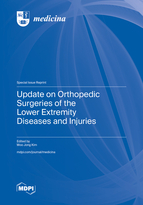Update on Orthopedic Surgeries of the Lower Extremity Diseases and Injuries
A special issue of Medicina (ISSN 1648-9144). This special issue belongs to the section "Orthopedics".
Deadline for manuscript submissions: closed (31 October 2023) | Viewed by 65764
Special Issue Editor
Interests: orthopaedics; lower extremity; foot and ankle; pathologies; disease; deformities; infection; total ankle arthroplasty; trauma; sports medicine; diabetic foot; orthoses
Special Issues, Collections and Topics in MDPI journals
Special Issue Information
Dear Colleagues,
The lower extremities, including the foot and ankle, are receiving an increasing amount of attention in the field of orthopedics compared to other parts of the body. Various diseases and deformities, trauma, and sports injuries can afflict this area of the body, and the field of orthopedics is evolving day by day.
Accordingly, there have been many developments in the field of orthopedic surgery, and a number of new challenges have emerged, and many researchers want to share updated knowledge and research. We are pleased to announce the launch of a new Special Issue, entitled “Update on Orthopedic Surgeries of the Lower Extremity Diseases and Injuries”. This Special Issue will focus on all emerging research papers related to lower extremity diseases or injuries, clinical studies, and trauma- and sports-related medical fields with regard to orthopedic surgeries. We look forward to inviting authors to submit reviews or original research that fit this scope.
Dr. Woo Jong Kim
Guest Editor
Manuscript Submission Information
Manuscripts should be submitted online at www.mdpi.com by registering and logging in to this website. Once you are registered, click here to go to the submission form. Manuscripts can be submitted until the deadline. All submissions that pass pre-check are peer-reviewed. Accepted papers will be published continuously in the journal (as soon as accepted) and will be listed together on the special issue website. Research articles, review articles as well as short communications are invited. For planned papers, a title and short abstract (about 100 words) can be sent to the Editorial Office for announcement on this website.
Submitted manuscripts should not have been published previously, nor be under consideration for publication elsewhere (except conference proceedings papers). All manuscripts are thoroughly refereed through a single-blind peer-review process. A guide for authors and other relevant information for submission of manuscripts is available on the Instructions for Authors page. Medicina is an international peer-reviewed open access monthly journal published by MDPI.
Please visit the Instructions for Authors page before submitting a manuscript. The Article Processing Charge (APC) for publication in this open access journal is 1800 CHF (Swiss Francs). Submitted papers should be well formatted and use good English. Authors may use MDPI's English editing service prior to publication or during author revisions.
Keywords
- disease in foot and ankle
- surgical treatment
- novel ideas and techniques
- trauma in lower extremity
- diabetic foot
- infection
- total ankle arthroplasty
- sports medicine
- systemic review and meta-analysis
- case report
- technical note







